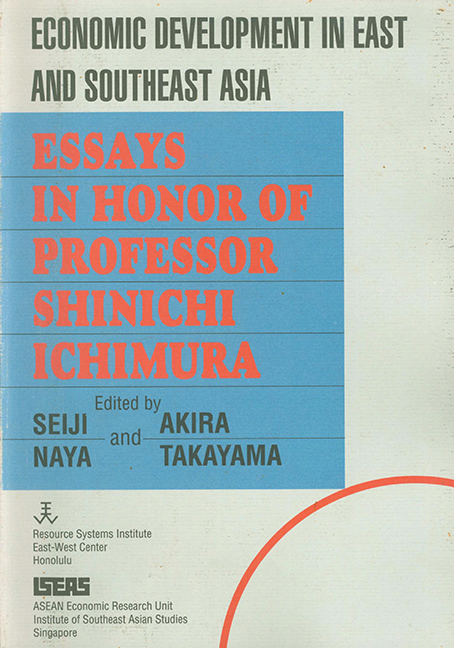Book contents
- Frontmatter
- Preface
- Shinichi Ichimura, 1925-
- CONTENTS
- Introduction
- Contributors to This Volume
- I Structural Change and Economic Development in Developing Asia in the 1990s
- II Explaining the Success of the Four Little Dragons: A Survey
- III Taiwan's Economic Miracle: A Singaporean Perspective
- IV Singapore's Experience of Industrial Restructuring: Lessons for the Other Asian NIEs
- V Korean Industrial Policies for Declining Industries
- VI Vietnam: Recent Economic Developments and the World Economy
- VII Transition from Import Substitution to Export Expansion: The Thai Experience
- VIII Adjustment Problems of a Small Oil-Exporting Country: Did Indonesia Suffer from the Dutch Disease?
- IX A Quarterly Econometric Model of the Hong Kong Economy
- X The Effect ofRicardian Rent Extracting on Macroeconomic Performance
- XI Direct Foreign Investment and the Economic Development of Korea
- XII Japanese Investment in Thailand: Looking Back and Into the Future
- XIII The Effects of Direct Foreign Investment on Taiwan: A Macroeconometric Investigation
- XIV A Reform of the Foward Foreign Exchange Market and Foreign Exchange Rate Determination Policy in Korea, with Foreign Exchange Policy Experiences of Taiwan
- XV Interest Rate and Foreign Exchange Liberalization in Taiwan in the 1980
- XVI Manifold Dilemmas behind External Debt Management
- XVII Agricultural Growth and Food Imports in Developing Countries: A Reexamination
- XVIII The Transformation of Rural Asia and Economic Development Theory and Policy
- XIX The ASEAN Summit and ASEAN Economic Cooperation
- XX The Role of Developing Countries in the New GATT Round
- XXI The Emerging Global Economy and the Role of the Asian NIEs
- Index
III - Taiwan's Economic Miracle: A Singaporean Perspective
Published online by Cambridge University Press: 21 October 2015
- Frontmatter
- Preface
- Shinichi Ichimura, 1925-
- CONTENTS
- Introduction
- Contributors to This Volume
- I Structural Change and Economic Development in Developing Asia in the 1990s
- II Explaining the Success of the Four Little Dragons: A Survey
- III Taiwan's Economic Miracle: A Singaporean Perspective
- IV Singapore's Experience of Industrial Restructuring: Lessons for the Other Asian NIEs
- V Korean Industrial Policies for Declining Industries
- VI Vietnam: Recent Economic Developments and the World Economy
- VII Transition from Import Substitution to Export Expansion: The Thai Experience
- VIII Adjustment Problems of a Small Oil-Exporting Country: Did Indonesia Suffer from the Dutch Disease?
- IX A Quarterly Econometric Model of the Hong Kong Economy
- X The Effect ofRicardian Rent Extracting on Macroeconomic Performance
- XI Direct Foreign Investment and the Economic Development of Korea
- XII Japanese Investment in Thailand: Looking Back and Into the Future
- XIII The Effects of Direct Foreign Investment on Taiwan: A Macroeconometric Investigation
- XIV A Reform of the Foward Foreign Exchange Market and Foreign Exchange Rate Determination Policy in Korea, with Foreign Exchange Policy Experiences of Taiwan
- XV Interest Rate and Foreign Exchange Liberalization in Taiwan in the 1980
- XVI Manifold Dilemmas behind External Debt Management
- XVII Agricultural Growth and Food Imports in Developing Countries: A Reexamination
- XVIII The Transformation of Rural Asia and Economic Development Theory and Policy
- XIX The ASEAN Summit and ASEAN Economic Cooperation
- XX The Role of Developing Countries in the New GATT Round
- XXI The Emerging Global Economy and the Role of the Asian NIEs
- Index
Summary
Quantitative Record and Evaluation
Growth in real income, 1952-87
From 1952 to 1987, Taiwan's real per capita income grew at a cumulative rate of 6.4 percent per annum. This rate of growth, which is also one of the highest in the world, implies that Taiwan's per capita income increased more than eightfold during the period. This is in contrast to the annual growth rate of about 2 percent in per capita income of the present Western industrial nations (Kuznets 1966). In other words, it took about 36 years for per capita income to double in these advanced economies, and it can be said that Taiwan grew 3 times as fast as the present industrial countries during the process of their industrialization. Another -way of looking at it is that Taiwan achieved in 36 years what it took an average of 108 years for the present developed industrial economies to achieve in their time. Against this historical perspective, Taiwan's post-war industrialization and development can be considered an economic miracle.
Taiwan's population increased from 8.1 million to 19.7 million between 1952 and 1987, an average increase of 2.6 percent per annum. In light of the discussion above, this means that Taiwan's productive capacity in terms of real GNP, as distinct from per capita GNP, must have grown much faster, averaging 8.9 percent per annum. This is one of the best economic performances in the world.
Structural transformation
Following the Second World War, the economic structure of Taiwan underwent dramatic changes with the predominantly agricultural economy giving way to a predominantly industrial economy. This economic metamorphosis is evidenced by the changing industrial composition of the working population. In 1952, 56 percent of the working population was in the primary sector, predominantly in agricultural activities. By 1987, the share of the working population in the primary sector had declined, and 43 percent of the working population was employed in the secondary sector, largely in manufacturing (Council for Economic Planning and Development 1988).
The economic transformation is also shown by the changing contribution of various economic activities to net domestic product (NDP). In 1952, the agricultural sector contributed 36 percent to NDP. This predominant position has been taken over by the manufacturing sector, which in 1987 made up 39 percent of NDP (Council for Economic Planning and Development 1988).
- Type
- Chapter
- Information
- Economic Development in East and Southeast AsiaEssays in Honor of Professor Shinichi Ichimura, pp. 38 - 56Publisher: ISEAS–Yusof Ishak InstitutePrint publication year: 1990



